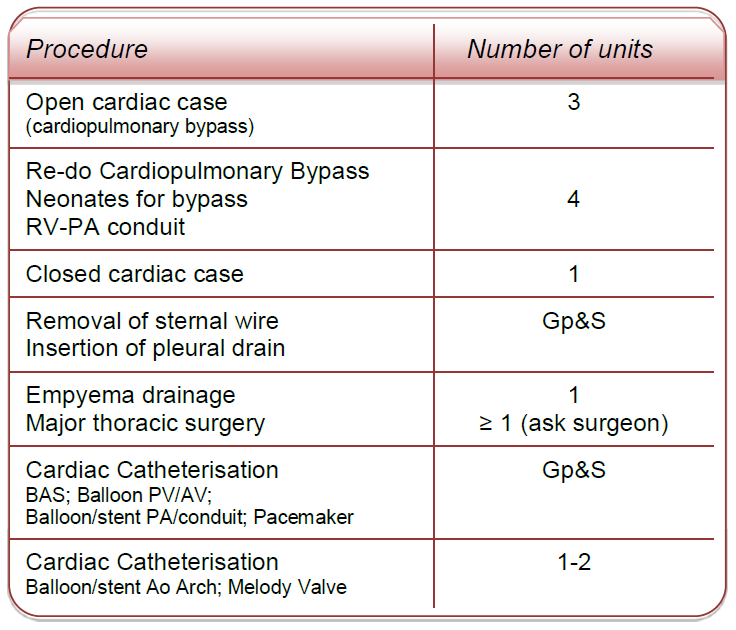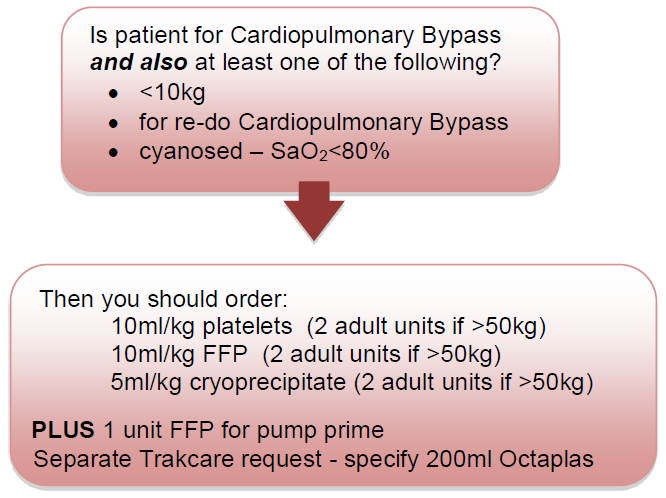Paediatric cardiac & thoracic surgery and cardiology ordering schedule for blood & blood products
exp date isn't null, but text field is
Objectives
A protocol for the transfusion requirements for paediatric cardiac, thoracic and cardiology patients undergoing a procedure.
Scope
Neonates, infants and children undergoing a cardiac, thoracic or cardiology procedure.
Audience
Medical and nursing staff in areas managing cardiac, thoracic and cardiology patients in the Royal Hospital for Children, Glasgow
This schedule indicates which Blood components and how much of each should be requested for patients undergoing cardiac and thoracic surgical or cardiology procedures. All surgical patients must have a minimum of Group & Save. A second sample is required if blood transfusion have no previous record of the patient’s blood group.
In an emergency, 4 units of Group O Negative blood are available in the Theatre blood fridge.
Please phone Blood Bank (ext 89104) if you have an urgent request or if requesting after 3pm for blood required the next day.

Some patients undergoing cardiopulmonary bypass require blood products to be available for theatre. These should be ordered on Trakcare. Enter the date of surgery and that theatre will phone when products are required.

Request irradiated RCC for patients with Di George syndrome and low CD3+/CD4+ count – discuss with ID, or those with chromosome analysis results outstanding. (see guideline: Cardiac Genetics Pathway for Infants with Congenital Heart Disease and the appropriate utilisation of irradiated blood)
Allow additional time for cross-match.
The Cardio-thoracic/ Cardiology medical team should contact Blood Bank in the event of cases being re-scheduled or cancelled: blood components may need to be reserved for longer or the order cancelled so that products can be used for other patients.
Minimum preferred sample size is 3 ml – please aim for this. Use large pink crossmatch tube.
Sample size affects number of units that can be cross-matched. Cyanosed patients require a larger sample to generate sufficient plasma for cross-match.
Samples <2ml require manual processing. To assist lab, hand write on form *short sample – please separate*
Note: This list of procedures is not exhaustive. If in doubt, please discuss with the surgical or anaesthetic team.
Open Cardiac Cases (Cardiopulmonary Bypass)
Aortic valve surgery
Atrial Septal Defect closure
Atrio-ventricular Septal Defect repair
Bidirectional Glenn procedure
Interrupted aortic arch repair
Left Ventricular Outflow Tract resection
Mitral valve surgery
Norwood procedure stage 1
Pulmonary Artery surgery
Pulmonary artery de-banding (as may require bypass)
Pulmonary Valve surgery
Rastelli procedure
RV-PA conduit construction
Tetralogy of Fallot repair
Transposition of the Great Arteries for arterial switch
Truncus Arteriosus repair
Total Anomalous Pulmonary Venous Drainage repair
Total Cavo-Pulmonary Connection
Ventricular Septal Defect
Closed Cardiac Cases
Blalock Taussig shunt
Coarctation of Aorta (if planned with left heart assist, treat as open case)
Defibrillator insertion
Pacemaker insertion
Patent Ductus Arteriosus – surgical ligation
Pulmonary Artery banding
Vascular Ring
Thoracic Cases
Congenital Lung Cyst excision
Lobectomy
Lung decortication
Cardiology
No Gp&S or x-match required:
Diagnostic cardiac catheterisation
ASD occlusion
PDA occlusion
Venous collateral/MAPCA occlusion
Radiofrequency ablation
Loop recorder insertion
Gp&S only:
Balloon dilation of pulmonary or aortic valve
Balloon / stenting of pulmonary artery or conduit
Balloon atrial septostomy
Transvenous pacemaker insertion
x-match 1 unit: Balloon / stenting of aortic arch
x-match 2 units: insertion of Melody valve
Last reviewed: 06 July 2021
Next review: 06 July 2023
Author(s): Anne Goldie & Elaine Harrison; Revised D Seddon Feb 2018
Version: 2
Approved By: Cardiac Guidelines Group, Hospital Transfusion Committee
Reviewer Name(s): A Goldie, A Hanlon

